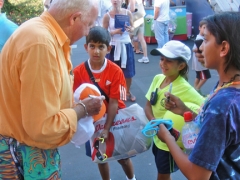
NEW YORK – As the 43rd season of the chase for dollars rolls toward its crescendo in Flushing (who will come out of it most flush?), few tennis junkies are aware that this monstrocity called the U.S. Open was once-upon-a-time a split personality.
It was in a day when something amusingly labeled as “amateurism” held sway, and room-and-board was a prized goal on the tournament circuit. That was prior to 1968 when the U.S. Championships were divided into separate tournaments: the Doubles in Boston at Longwood Cricket Club, followed by the Singles at Forest Hills (the West Side Tennis Club in New York).
It wasn’t a bad arrangement. The Flyin’ Bryans would have loved it, a week devoted to doubles (thereafter neglected) with their best-of-5-set matches on center stage. A plus for the customers was seeing the best men and women frolicking at doubles on grass courts. They had to play doubles because it was the only thing scheduled that week. Doesn’t happen now. Too bad. It was also a fine opportunity for the Europeans and Latins to work on their grass games prior to the Singles.
But “opens” and cash payments dawned in 1968. Everything moved to a big tent — the U.S. Open — at Forest Hills. In 1967 that seemed an unstable notion. Yet unexpectedly it was the last year of the split, thanks to Herman David, the boss at Wimbledon, and USTA President Bob Kelleher, who rammed opens down the unwilling throats of the rest of the world. Fortunately for the game.
So the star of the folding old ways of the U.S. was the gregarious Aussie JohnNewcombe. He and compatriot Tony Roche, holders of the record 12 major titles, won the U.S., a prelude to Newcombe beating American Clark Graebner for singles supremacy . Immediately Newc and Tony turned pro, along with Cliff Drysdale, Roger Taylor, and Nikki Pilic, joining seasoned pros Dennis Ralston, Pierre Barthes and Butch Buchholz in a troupe called WCT (World Championship tennis) as amateurism fell apart.
But what of Boston and Longwood, promoters of international tourneys since 1890? With the Doubles gone to New York, the USTA decided to continue the tradition of an amateur championship, and located the U.S. Amateur at Longwood.
That set up a never-to-be-equalled feat by a U.S. Army lieutenant named Arthur Ashe, hardly known at the time. Arthur was on fire as he beat Davis Cup teammate Bob Lutz in 5 sets for the title.
Off the players went to New York and the opening Open. Lightly regarded, what with Rod Laver, Ken Rosewall, Pancho Gonzalez, Tom Okker and Newcombe and Roche in the mix, Ashe maintained his flame to burn Okker in 5 sets for the championship. Ashe, the amateur, got $ 20 day expenses; Okker, the pro, got the $ 12,000 first prize.
It will never happen again — the same guy wearing the Amateur and Open crowns in the same year. Ashe’s rush to the Amateur had been covered by PBS, the Open by CBS. Arthur was suddenly The Man in Demand, turning pro when his Army time was finished, leading the U.S. to 3 Davis Cups, winning Wimbledon in 1975, entering the Hall of Fame in 1985.
As a copyboy for the since-vanished Boston Herald, I covered my first major, the U.S. Doubles, at Longwood in 1955. Why? Because the established guys on the staff thought covering tennis was below them. But I was thrilled when the sports editor, Eddie Costello, almost apologetically, assigned me — “you’re the rookie, Junior.”

Tony Trabert and Vic Seixas, the U.S. Davis Cup team. were defending the title, having beaten the Aussie kids, Lew Hoad and Ken Rosewall, in ’54. The thrill didn’t last as Boston was struck by Hurricane Diane, flooding the grass courts on which ballboys rowed boats and swam for the benefit of photographers.
By the time the courts were muckily playable again, most players had moved on, believing the tournament would never end. All-timers with 20 majors, Margaret duPont and Louise Brough did stick around to win their 10th U.S. title over Doris Hart and Shirley Fry, a clash of future Hall of Famers.
But nobody knew the men’s finalists: Japanese Kosei Kamo and Atsushi Miyagi against American college boys Jerry Moss and Bill Quillian. Winning in 5 sets, the Japanese provoked a laugh from the veteran groundskeeper, Charlie Chambers. “All summer Japanese beetles were a problem for me. Now it’s Japanese guys giving the Americans a problem.”
Clearly pleased, but very modest about taking a U.S. title back to Japan, Kamo and Miyagi didn’t do much at Forest Hills. But they had a major championship, and I had my first foreign champs.
Leave a Reply